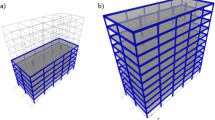Abstract
Rigid pavement is one of the pavement methods used specially in high traffic zones. Up till now, Portland cement concrete (PCC) is the most commonly used material for rigid pavement. One of the problems that faces PCC is the allowable spacing for transverse joints in rigid pavements’ plain concrete slabs. As recommended by different standards and design manuals, the recommended length of slabs is about 4.5–5 m (In PCA, Thickness Design for Concrete Highway and Street Pavements. Engineering Bulletin EB109P. Skokie, IL, (1984); In ECP, Egyptian code of practice for urban and rural roads part 4: road material and its tests. Housing and Building National Research Center, Egypt, (2018); In FDOT, Rigid Pavement Design Manual. Pavement Management Office, Document No. 625-010-006-e, Tallahassee, Florida, (2009)), this is referred to the thermal volumetric changes in PCC. The low allowable transverse joints spacing in rigid pavement reduces the implementation rates and increases the cost. Geopolymer concrete (GPC) is one of the innovative types of concrete that is eco-friendly than gain early strength in ambient temperature and can gain higher strength by heating. In this research, GPC was investigated to determine its drying shrinkage and thermal expansion behavior and therefore affect the length of concrete slabs in rigid pavement. This different type of concrete showed an acceptable performance against drying shrinkage and thermal expansion more than PCC.








Similar content being viewed by others
References
Davidovits J, Cordi SA (1979) Synthesis of new high temperature geo-polymers for reinforced plastics/composites. Soc Plast Eng 79:151–154
PCA (1988) US Portland cement association. Design and control of concrete mixtures. Skokie, IL: Portland cement association
Hardjito D, Wallah SE, Sumajouw DM, Rangan BV (2004) On the development of fly ash-based geopolymer concrete. Mater J 101(6):467–472
Wallah S, Rangan BV (2006) Low-calcium fly ash-based geopolymer concrete: long-term properties. Research Report GC 2, Faculty of Engineering, Curtin University of Technology, Perth, Australia
Lee NP (2007) Creep and shrinkage of inorganic polymer concrete. BRANZ Study Report SR 175, BRANZ Ltd, Judgeford, New Zealand
Wallah SE (2009) Drying shrinkage of heat-cured fly ash-based geopolymer concrete. Modern Appl Sci 3(12):14–21
Ridtirud C, Chindaprasirt P, Pimraksa K (2011) Factors affecting the shrinkage of fly ash geopolymers. Int J Miner Metall Mater 18(1):100–104
Shekhovtsova J, Kovtun M, Kearsley EP (2015) Evaluation of short-and long-term properties of heat-cured alkali-activated fly ash concrete. Mag Concr Res 67(16):897–905
Castel A, Foster SJ, Ng T, Sanjayan JG, Gilbert RI (2016) Creep and drying shrinkage of a blended slag and low calcium fly ash geopolymer concrete. Mater Struct 49(5):1619–1628
Collins FG, Sanjayan JG (1999) Workability and mechanical properties of alkali activated slag concrete. Cem Concr Res 29(3):455–458
Thomas RJ, Lezama D, Peethamparan S (2017) On drying shrinkage in alkali-activated concrete: improving dimensional stability by aging or heat-curing. Cem Concr Res 91:13–23
PCA (1984) US Portland cement association. Thickness design for concrete highway and street pavements. Engineering bulletin EB109P. Skokie, IL: Portland cement association
ECP (2018) Egyptian code of practice for urban and rural roads part 4: road material and its tests. Housing and Building National Research Center, Egypt
FDOT (2009) Florida Department of Transportation. Rigid Pavement Design Manual. Pavement Management Office, Document No. 625–010–006-e, Tallahassee, Florida
ASTM C596 (2018) Standard test method for drying shrinkage of mortar containing hydraulic cement. ASTM International, West Conshohocken, PA
ASTM C531 (2018) Standard test method for linear shrinkage and coefficient of thermal expansion of chemical-resistant mortars, grouts, monolithic surfacings, and polymer concretes. ASTM International, West Conshohocken, PA
Refaei DA, Abdelrahman MK, Ibrahim IA, Eldears F, Kandil AT (2016) Improvement the quality of Egyptian kaolin for industrial applications. Int J Adv Technol 8:174
British Standards Institution BS EN 197-1 (2011) Cement: Composition, specifications and conformity criteria for common cements. London, UK
Egyptian Standard Specification (ESS) 4576-1 (2009) Composition, specifications and conformity criteria for common cements, Egyptian organization for standards and quality (EOS), Cairo, Egypt
Egyptian Code of Practice for Design and Construction of Reinforced Concrete Structures (ECP 203-2018). Ministry of Housing, Utilities and Urban Communities. Cairo, Egypt
ASTM C494/C494M (2019) Standard specification for chemical admixtures for concrete. ASTM International, West Conshohocken, PA
Rangan BV (2008) Fly ash-based geopolymer concrete. Research report GC4, Faculty of Engineering, Curtin University of Technology, Perth, Australia
Anuradha R, Sreevidya V, Venkatasubramani R, Rangan BV (2012) Modified guidelines for geopolymer concrete mix design using Indian standard. Asian J Civ Eng (Building and Housing) 13(3):353–364
Ferdous MW, Kayali O, Khennane A (2013) A detailed procedure of mix design for fly ash based geopolymer concrete. In: Proceedings of the Fourth Asia-Pacific Conference on FRP in Structures (APFIS 2013), Melbourne, Australia (pp. 11–13)
Patankar SV, Ghugal YM, Jamkar SS (2015) Mix design of fly ash based geopolymer concrete. In: Matsagar V (ed) Advances in structural engineering. Springer, New Delhi, pp 1619–1634
Shi C (1996) Strength, pore structure and permeability of alkali-activated slag mortars. Cem Concr Res 26(12):1789–1799
Bakharev T, Sanjayan JG, Cheng YB (1999) Alkali activation of Australian slag cements. Cem Concr Res 29(1):113–120
ASTM C157/C157M (2017) Standard test method for length change of hardened hydraulic-cement mortar and concrete. ASTM International, West Conshohocken, PA
Heath AC, Roesler JR (1999) Shrinkage and thermal cracking of fast setting hydraulic cement concrete pavements in Palmdale. Pavement Research Center, Institute of Transportation Studies, University of California, Berkeley, California
Deb PS, Nath P, Sarker PK (2015) Drying shrinkage of slag blended fly ash geopolymer concrete cured at room temperature. Procedia Eng 125:594–600
Acknowledgments
The authors are thankful to the teamwork of Housing and Building National Research Center, Egypt
Author information
Authors and Affiliations
Corresponding author
Ethics declarations
Conflict of interest
The author declares that they have no conflict of interest.
Rights and permissions
About this article
Cite this article
Eisa, M.S., Basiouny, M.E. & Fahmy, E.A. Effect of metakaolin-based geopolymer concrete on the length of rigid pavement slabs. Innov. Infrastruct. Solut. 6, 91 (2021). https://doi.org/10.1007/s41062-021-00465-5
Received:
Accepted:
Published:
DOI: https://doi.org/10.1007/s41062-021-00465-5




